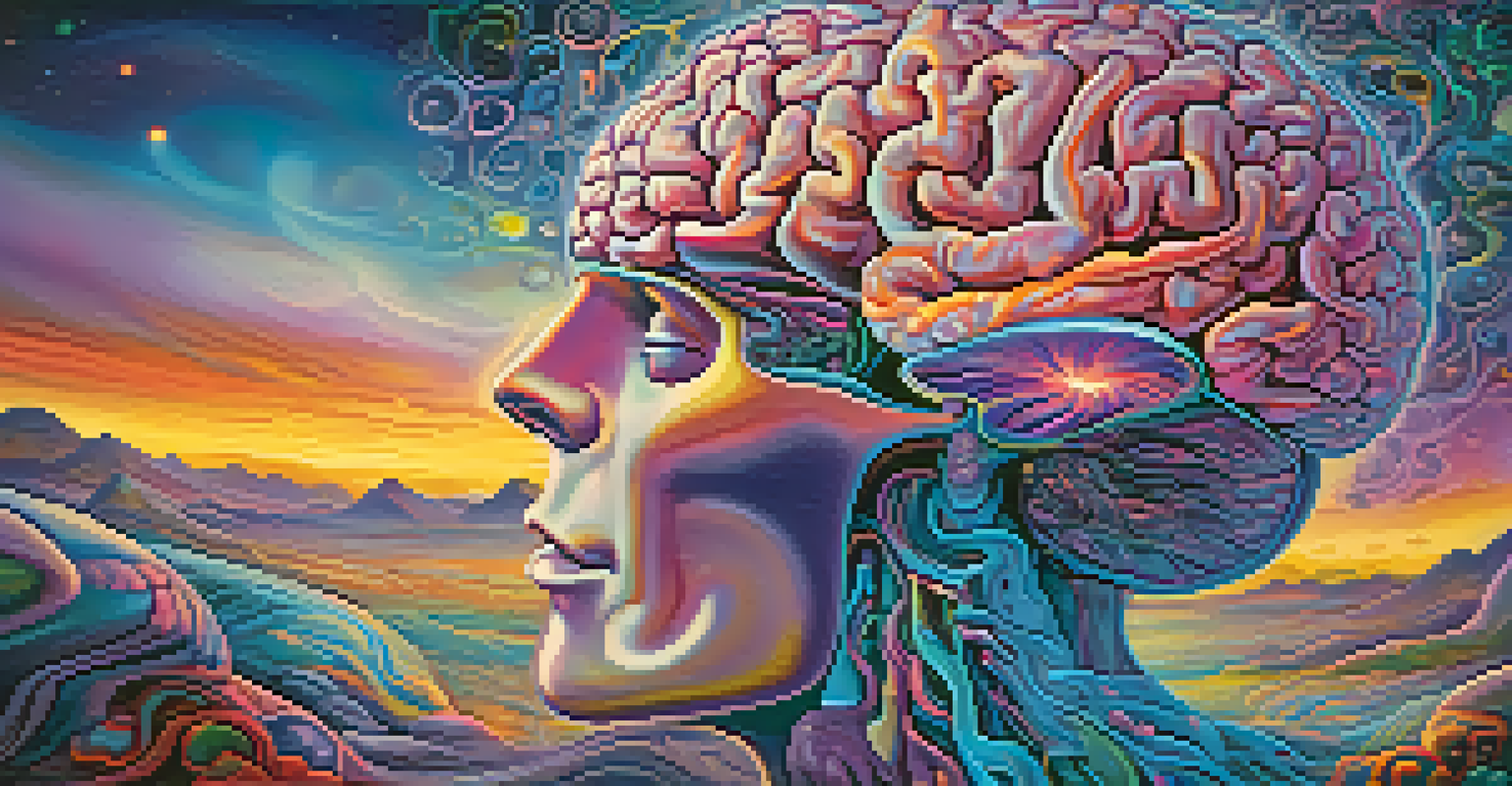Exploring Non-Ordinary States of Consciousness with Psychedelics

Understanding Non-Ordinary States of Consciousness
Non-ordinary states of consciousness refer to altered states that differ from our typical waking experience. These states can occur spontaneously during meditation, dreams, or through the use of psychedelics. They often provide unique insights and perspectives that can shift one’s understanding of reality.
Psychedelics can help us to see the world differently, to expand our consciousness, and to connect with the deeper aspects of our being.
Psychedelics, such as LSD, psilocybin (magic mushrooms), and DMT, are substances that have been used for centuries in various cultures to explore these altered states. They can induce profound changes in perception, emotion, and thought, leading to experiences that feel transcendent or mystical. Understanding these states can help us tap into deeper layers of our consciousness.
Exploring non-ordinary states of consciousness can be beneficial for personal growth, creativity, and healing. By stepping outside of our everyday mental frameworks, we may uncover insights that can guide us in our lives, relationships, and even our understanding of the universe.
A Brief History of Psychedelic Use
The use of psychedelics dates back thousands of years, with indigenous cultures utilizing these substances for ritualistic and spiritual purposes. For instance, the Mazatec people of Mexico have long used psilocybin mushrooms in their healing ceremonies. This rich history highlights the deep connection between psychedelics and spiritual exploration.

In the mid-20th century, psychedelics gained popularity in Western society, particularly during the counterculture movement. Figures like Timothy Leary advocated for their use as a means of expanding consciousness and exploring the mind. However, the subsequent backlash led to a period of stigma and legal restrictions around these substances.
Psychedelics and Consciousness
Psychedelics can induce non-ordinary states of consciousness, offering profound insights and emotional experiences.
Today, there’s a resurgence of interest in psychedelics, particularly for their therapeutic potential. Researchers are exploring how these substances can aid in treating mental health issues such as depression, anxiety, and PTSD, paving the way for a new understanding of their value.
How Psychedelics Affect the Brain
Psychedelics primarily affect the brain's serotonin receptors, particularly the 5-HT2A receptor. This interaction leads to altered sensory perceptions, emotional responses, and cognitive processes. It’s akin to tuning a radio to a different frequency, allowing users to experience the world in a unique way.
The therapeutic potential of psychedelics is vast, and we are just beginning to understand how they can transform mental health care.
During a psychedelic experience, individuals might find their thoughts and emotions becoming more fluid and interconnected. This can lead to a sense of unity with nature, others, or even the universe. Some describe it as breaking down barriers between the self and the external world, resulting in profound feelings of love and connection.
Additionally, psychedelics can stimulate the default mode network (DMN) in the brain, which is associated with self-referential thoughts and ego. When this network is disrupted, it can lead to experiences of ego dissolution, where individuals feel a loss of their usual sense of self, which can be both terrifying and liberating.
The Therapeutic Potential of Psychedelics
Recent studies have shown promising results for the therapeutic use of psychedelics. For instance, psilocybin has been found effective in alleviating depression, with some participants reporting lasting changes in mood and outlook. This has sparked interest in using psychedelics as a tool for mental health treatment.
Psychedelics have also shown potential in treating addiction, anxiety, and PTSD. The experiences they provide can help individuals confront deep-seated emotional issues, often leading to breakthroughs that traditional therapies may not achieve. Many therapists are advocating for integrating psychedelics into psychotherapy for enhanced outcomes.
Therapeutic Benefits of Psychedelics
Research shows psychedelics hold potential for treating mental health issues like depression and PTSD, promoting healing and personal growth.
As research continues to unfold, the potential for psychedelics in therapeutic settings appears to be significant. The combination of guided therapy with psychedelic experiences could provide a holistic approach to mental health, promoting healing and self-discovery.
Navigating the Psychedelic Experience Safely
Engaging with psychedelics requires careful consideration of set and setting. 'Set' refers to the mindset of the individual, while 'setting' is the environment in which the experience takes place. Both play crucial roles in how one may perceive and integrate their psychedelic journey.
For a safe experience, it's essential to choose a comfortable and familiar space, preferably with trusted companions. Having a guide or sitter can also enhance safety, providing support and reassurance throughout the experience. This can be especially important if challenging emotions or thoughts arise.
It's equally vital to consider the dosage and the specific substance being used. Starting with a lower dose can help gauge individual sensitivity and reactions. By prioritizing safety, individuals can maximize the potential benefits of their psychedelic exploration.
Integration: Making Sense of the Experience
Integration refers to the process of understanding and incorporating insights gained during a psychedelic experience into everyday life. This step is crucial, as the revelations can be profound, yet challenging to articulate. Taking time to reflect on the experience can help individuals grasp its significance.
Practices such as journaling, meditation, or discussing the experience with a therapist or supportive community can aid in this process. Sharing insights with others can also provide additional perspectives, enriching one’s understanding. It’s like piecing together a puzzle to reveal a larger picture.
Safe Exploration of Psychedelics
Engaging with psychedelics requires careful attention to set and setting to ensure a safe and meaningful experience.
The goal of integration is to translate the often ineffable insights gained into actionable changes in one’s life. Whether it’s fostering deeper connections with others, embracing creativity, or pursuing personal growth, integration allows individuals to apply their newfound understanding meaningfully.
The Future of Psychedelics in Society
As research continues to highlight the benefits of psychedelics, there is a growing movement towards decriminalization and acceptance of these substances. Cities like Denver and Oakland have already taken steps to decriminalize psilocybin mushrooms, reflecting a shift in societal attitudes. This could pave the way for broader access and awareness.
The future of psychedelics also holds promise for innovation in mental health treatment. With ongoing clinical trials and research, we may see psychedelics becoming standard practice in therapeutic settings. This could revolutionize how we approach mental health care, providing patients with more options.

Ultimately, the conversation around psychedelics is evolving. As we continue to explore their potential, it’s essential to balance curiosity with caution, ensuring that these powerful substances are used responsibly and ethically in society.